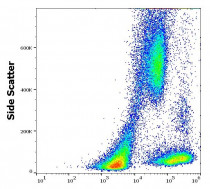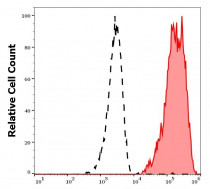ARG62708
anti-CD11a / LFA1 alpha antibody [MEM-83]
anti-CD11a / LFA1 alpha antibody [MEM-83] for Flow cytometry,Functional study,Immunoprecipitation and Human
Developmental Biology antibody; Immune System antibody; Signaling Transduction antibody
Overview
| Product Description | Mouse Monoclonal antibody [MEM-83] recognizes CD11a / LFA1 alpha |
|---|---|
| Tested Reactivity | Hu |
| Tested Application | FACS, FuncSt, IP |
| Specificity | The clone MEM-83 reacts with CD11a (alpha subunit of human LFA-1), a 170-180 kDa type I transmembrane glycoprotein expressed on B and T lymphocytes, monocytes, macrophages, neutrophils, basophils and eosinophils. HLDA IV; WS Code N 211 |
| Host | Mouse |
| Clonality | Monoclonal |
| Clone | MEM-83 |
| Isotype | IgG1 |
| Target Name | CD11a / LFA1 alpha |
| Antigen Species | Human |
| Immunogen | Human peripheral blood lymphocytes |
| Conjugation | Un-conjugated |
| Alternate Names | Leukocyte adhesion glycoprotein LFA-1 alpha chain; LFA1A; LFA-1A; Integrin alpha-L; CD11A; Leukocyte function-associated molecule 1 alpha chain; LFA-1; CD11 antigen-like family member A; CD antigen CD11a |
Application Instructions
| Application Suggestion |
|
||||||||
|---|---|---|---|---|---|---|---|---|---|
| Application Note | Functional studies: The clone MEM-83 directly induces the binding of T cells to purified ICAM-1. Using an in vitro-translated CDlla cDNA deletion series, the MEM-83 activation epitope was mapped to the "I" domain of the LFA-1 alpha subunit. The studies have therefore identified a novel LFA-1 activation epitope mapping to the I domain of LFA-1, which could play a role in the regulation of LFA-1 binding to ICAM-1. * The dilutions indicate recommended starting dilutions and the optimal dilutions or concentrations should be determined by the scientist. |
Properties
| Form | Liquid |
|---|---|
| Purification | Purified from ascites by protein-A affinity chromatography. |
| Purity | > 95% (by SDS-PAGE) |
| Buffer | PBS (pH 7.4) and 15 mM Sodium azide |
| Preservative | 15 mM Sodium azide |
| Concentration | 1 mg/ml |
| Storage Instruction | For continuous use, store undiluted antibody at 2-8°C for up to a week. For long-term storage, aliquot and store at -20°C or below. Storage in frost free freezers is not recommended. Avoid repeated freeze/thaw cycles. Suggest spin the vial prior to opening. The antibody solution should be gently mixed before use. |
| Note | For laboratory research only, not for drug, diagnostic or other use. |
Bioinformation
| Database Links | |
|---|---|
| Gene Symbol | ITGAL |
| Gene Full Name | integrin, alpha L (antigen CD11A (p180), lymphocyte function-associated antigen 1; alpha polypeptide) |
| Background | CD11a (LFA-1 alpha) together with CD18 constitute leukocyte function-associated antigen 1 (LFA-1), the alphaLbeta2 integrin. CD11a is implicated in activation of LFA-1 complex. LFA-1 is expressed on the plasma membrane of leukocytes in a low-affinity conformation. Cell stimulation by chemokines or other signals leads to induction the high-affinity conformation, which supports tight binding of LFA-1 to its ligands, the intercellular adhesion molecules ICAM-1, -2, -3. LFA-1 is thus involved in interaction of various immune cells and in their tissue-specific settlement, but participates also in control of cell differentiation and proliferation and of T-cell effector functions. Blocking of LFA-1 function by specific antibodies or small molecules has become an important therapeutic approach in treatment of multiple inflammatory diseases. For example, humanized anti-LFA-1 antibody Efalizumab (Raptiva) is being used to interfere with T cell migration to sites of inflammation; binding of cholesterol-lowering drug simvastatin to CD11a allosteric site leads to immunomodulation and increase in lymphocytic cholinergic activity. |
| Function | Integrin alpha-L/beta-2 is a receptor for ICAM1, ICAM2, ICAM3 and ICAM4. It is involved in a variety of immune phenomena including leukocyte-endothelial cell interaction, cytotoxic T-cell mediated killing, and antibody dependent killing by granulocytes and monocytes. [UniProt] |
| Research Area | Developmental Biology antibody; Immune System antibody; Signaling Transduction antibody |
| Calculated MW | 129 kDa |
| PTM | In resting T-cells, up to 40% of surface ITGAL is constitutively phosphorylated. Phosphorylation causes conformational changes needed for ligand binding and is necessary for activation by some physiological agents. |
Images (2) Click the Picture to Zoom In
-
ARG62708 anti-CD11a / LFA1 alpha antibody [MEM-83] FACS image
Flow Cytometry: Human peripheral blood cells stained with ARG62708 anti-CD11a / LFA1 alpha antibody [MEM-83] at 1 µg/ml dilution, followed by APC-conjugated Goat anti-Mouse antibody.
-
ARG62708 anti-CD11a / LFA1 alpha antibody [MEM-83] FACS image
Flow Cytometry: Separation of human CD11a positive lymphocytes (red-filled) from CD11a negative blood debris (black-dashed). Human peripheral whole blood stained with ARG62708 anti-CD11a / LFA1 alpha antibody [MEM-83] at 1 µg/ml dilution, followed by APC-conjugated Goat anti-Mouse antibody.
Clone References









